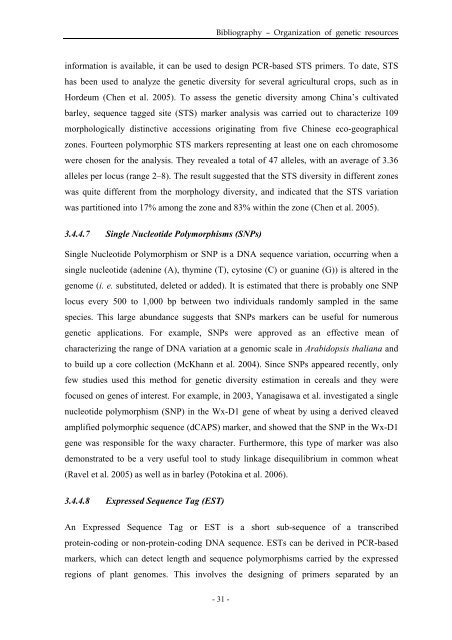Etude de la portabilité de marqueurs microsatellites issus d'EST de ...
Etude de la portabilité de marqueurs microsatellites issus d'EST de ...
Etude de la portabilité de marqueurs microsatellites issus d'EST de ...
Create successful ePaper yourself
Turn your PDF publications into a flip-book with our unique Google optimized e-Paper software.
Bibliography – Organization of genetic resources<br />
information is avai<strong>la</strong>ble, it can be used to <strong>de</strong>sign PCR-based STS primers. To date, STS<br />
has been used to analyze the genetic diversity for several agricultural crops, such as in<br />
Hor<strong>de</strong>um (Chen et al. 2005). To assess the genetic diversity among China’s cultivated<br />
barley, sequence tagged site (STS) marker analysis was carried out to characterize 109<br />
morphologically distinctive accessions originating from five Chinese eco-geographical<br />
zones. Fourteen polymorphic STS markers representing at least one on each chromosome<br />
were chosen for the analysis. They revealed a total of 47 alleles, with an average of 3.36<br />
alleles per locus (range 2–8). The result suggested that the STS diversity in different zones<br />
was quite different from the morphology diversity, and indicated that the STS variation<br />
was partitioned into 17% among the zone and 83% within the zone (Chen et al. 2005).<br />
3.4.4.7 Single Nucleoti<strong>de</strong> Polymorphisms (SNPs)<br />
Single Nucleoti<strong>de</strong> Polymorphism or SNP is a DNA sequence variation, occurring when a<br />
single nucleoti<strong>de</strong> (a<strong>de</strong>nine (A), thymine (T), cytosine (C) or guanine (G)) is altered in the<br />
genome (i. e. substituted, <strong>de</strong>leted or ad<strong>de</strong>d). It is estimated that there is probably one SNP<br />
locus every 500 to 1,000 bp between two individuals randomly sampled in the same<br />
species. This <strong>la</strong>rge abundance suggests that SNPs markers can be useful for numerous<br />
genetic applications. For example, SNPs were approved as an effective mean of<br />
characterizing the range of DNA variation at a genomic scale in Arabidopsis thaliana and<br />
to build up a core collection (McKhann et al. 2004). Since SNPs appeared recently, only<br />
few studies used this method for genetic diversity estimation in cereals and they were<br />
focused on genes of interest. For example, in 2003, Yanagisawa et al. investigated a single<br />
nucleoti<strong>de</strong> polymorphism (SNP) in the Wx-D1 gene of wheat by using a <strong>de</strong>rived cleaved<br />
amplified polymorphic sequence (dCAPS) marker, and showed that the SNP in the Wx-D1<br />
gene was responsible for the waxy character. Furthermore, this type of marker was also<br />
<strong>de</strong>monstrated to be a very useful tool to study linkage disequilibrium in common wheat<br />
(Ravel et al. 2005) as well as in barley (Potokina et al. 2006).<br />
3.4.4.8 Expressed Sequence Tag (EST)<br />
An Expressed Sequence Tag or EST is a short sub-sequence of a transcribed<br />
protein-coding or non-protein-coding DNA sequence. ESTs can be <strong>de</strong>rived in PCR-based<br />
markers, which can <strong>de</strong>tect length and sequence polymorphisms carried by the expressed<br />
regions of p<strong>la</strong>nt genomes. This involves the <strong>de</strong>signing of primers separated by an<br />
- 31 -

















